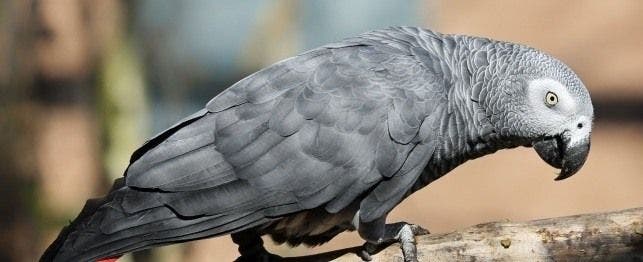
Choosing a Congo African Grey
African greys are often considered to be the best talkers of all parrots, rivaled only by some Amazons. They are gifted mimics, reproducing sounds such as ringing telephones, microwave buzzers, car horns and the voices of individuals. Some Psittacus erithacus are highly trained birds, capable of reasoning and verbal communication.
The birds often don’t speak well until they are approximately a year old; usually, they start by mimicking sounds. Wild-caught birds have an extraordinary repertoire of whistles, clicks and calls and often sing and whistle during the night, especially on nights with a full moon. Although these birds talk incessantly, they don’t usually create the kind of noise problems associated with some other parrot species.
Behavior and Personality
African greys are very common and are one of the most popular and most frequently bred parrots in the United States. Since they are happiest left alone, they make good pets for people who live in quiet homes, particularly in homes without children. But since they are extremely intelligent, they require many toys and some interaction to prevent behavior problems.
Young birds adapt readily to new surroundings and should be exposed to new experiences. Adults are less adaptable and may feather pick in response to changes in their routine. In fact, African greys have a higher incidence of feather-picking problems than most parrot species.
The birds – which can live up to 50 years – are stocky, short-tailed, and colored varying shades of gray, depending on the sex and where in their range they occur. The tail is bright red and the beak is black. African greys have a powdery white facial patch that extends from the beak to around the eye. The birds also produce a powdery substance that helps to clean and protect their feathers, but may be allergenic in some people.
Congo African grey parrots range through western equatorial Africa – from the Ivory Coast to western Kenya, Angola, Tanzania and southern Zaire. They inhabit primary and secondary rainforest, forest edges and clearings, mostly in lowland areas. They’re gregarious, roosting in colonies of up to 10,000 individuals.
Birds of the eastern areas of the greys’ range – in parts of Kenya, Tanzania and Zaire – tend to be larger and lighter in color. The eastern populations also tend to have some slight red coloring in the feathers. The smaller and darker birds occur in the western parts of the range, from Ivory Coast to Angola.
African greys are very playful and are easily bored, so they should always be provided with toys – especially wooden blocks or other objects they can chew on – and branches from non-toxic trees.
Grooming
Routine bathing or showering is vital to maintaining good plumage and skin condition. Bathing will also reduce feather dust. Birds can be misted and allowed to dry in a warm room or in the sun, or dried with a blow drier. Care should be taken not to clip the wing feathers excessively as African greys often fall and injure themselves, so clip only enough so the bird will glide to the floor.
When restraining African greys for grooming, they may produce tears containing blood. Presumably, these are caused by ruptures of the capillaries in the eye and do not appear to have any detrimental effect.
Feeding
African greys kept as indoor pets especially tend to develop calcium deficiency, which can be a serious health threat. Natural or full spectrum light seems to be important in helping them to maintain calcium balance. There are also specially formulated foods that provide readily utilizable calcium to help prevent deficiency.
African greys should be fed approximately 1/3 cup of a pelleted diet daily. The diet should be supplemented with approximately 1/4 to 1/3 cup of fresh fruits and vegetables daily to add variety. Seeds and other treats may be given in small amounts as rewards for good behavior. Fresh, clean water must be provided every day.
Vitamin supplements are not needed for birds on a pelleted diet. African greys love peanuts, but they should be shelled before you give them to your bird as they are often contaminated with Aspergillus fungus, which can lead to aspergillosis, a respiratory disease.
African greys are easy to hand-rear, although care must be taken in feeding very small chicks as they are easily aspirated. Chicks wean or fledge at approximately 12 to 14 weeks. Since they are subject to bony deformities, such as crooked necks and legs, calcium supplementation may be beneficial but should not be excessive.
Housing
African parrots are very active and should be provided with as large a cage as possible. The cage should have two perches so the birds can move between them. Toys and activities should be provided.
Breeding
African greys breed well in captivity. Some will breed year round but most breed in the winter and early spring. Clutch size is usually two to four eggs. Some breeding greys are very shy and need privacy to breed well; some spend virtually all their time in the nest box if humans are nearby. Very shy birds may breed better in shady areas or in boxes with partitions to reduce light in the interior of the box.
African greys will use a vertical, horizontal nest box 18 inches by 18 inches by 24 inches or an L-shaped box. Cage size should be at least 4 feet by 4 feet by 4 feet or 3 feet by 3 feet by 6 feet.
Common Diseases and Disorders
African greys are relatively healthy birds but are susceptible to the following:
- Feather picking
- Psittacosis – parrot fever
- Psittacine beak and feather disease
- Respiratory diseases – aspergillosis
- Sarcocystis infection – intestinal parasites
- Bacterial, viral, fungal diseases
- Calcium deficiency disorder
- Tumors
- Tapeworms
- Cryptosporidiosis – gastroenteritis
- Bleeding-eye syndrome
- Chicks – aspiration and bony deformities (crooked neck, leg deformities, pathological fractures)